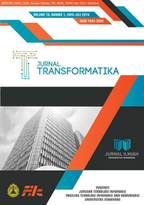Making Of Flash Card And Augmented Reality-Based Application As A Learning Media For Children With Special Needs
DOI:
https://doi.org/10.26623/transformatika.v16i2.923Keywords:
augmented reality, flash card, special needs childrenAbstract
This study aims to measure the level of effectiveness of the use of flash cards and applications based on Augmented Reality as a learning aid. The use of Android applications and AR cards that can also function as flash cards has proven to attract interest and increase student motivation in learning. Number recognition material and addition of unit numbers are chosen as the initial experiment stage which aims to introduce the use of assistive devices in the form of tablet PCs or smartphones to the children. Based on the results of the study, both teachers and students felt helped by the existence of this application as a variety of learning media. The research method used in this study is Multiple Baseline Design Across Subjects, while the sampling technique used is census sampling technique.
Downloads
Published
Issue
Section
License
Authors who publish with this journal agree to the following terms:
- Authors retain copyright and grant the journal right of first publication with the work simultaneously licensed under a Creative Commons Attribution License that allows others to share the work with an acknowledgement of the work's authorship and initial publication in this journal.
- Authors are able to enter into separate, additional contractual arrangements for the non-exclusive distribution of the journal's published version of the work (e.g., post it to an institutional repository or publish it in a book), with an acknowledgement of its initial publication in this journal.
- Authors are permitted and encouraged to post their work online (e.g., in institutional repositories or on their website) prior to and during the submission process, as it can lead to productive exchanges, as well as earlier and greater citation of published work.

Transformatika is licensed under a Creative Commons Attribution 4.0 International License.


